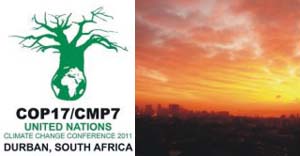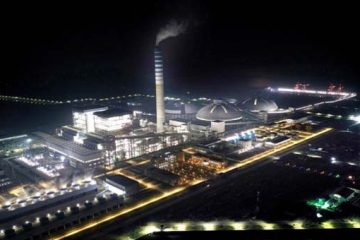How close the world is?
Shammunul Islam
 The 17th United Nations Framework Convention on Climate Change (COP 17) will be held in the city of Durban, South Africa from November 28 to December 9. The world is waiting with hope that this time a fruitful and effective guideline will be made towards mitigating and adapting with climate change impacts. Much hype and expectation grew vis-a-vis this convention mainly hangs around the moods and stances of developed and some major developing countries. These countries aligned with capitalist interest may act as the main hindrance to a positive outcome from COP 17.
The 17th United Nations Framework Convention on Climate Change (COP 17) will be held in the city of Durban, South Africa from November 28 to December 9. The world is waiting with hope that this time a fruitful and effective guideline will be made towards mitigating and adapting with climate change impacts. Much hype and expectation grew vis-a-vis this convention mainly hangs around the moods and stances of developed and some major developing countries. These countries aligned with capitalist interest may act as the main hindrance to a positive outcome from COP 17.
Capitalism which requires rapid accumulation of capital has resulted into a continuous series of exchange between humans and the earth’s ecological system that went beyond its tipping point. This mind-boggling behavior of inhabitants resulted into multi-dimensional global environmental crisis which forebodes extermination of the basis of civilisation and the survival of the human species.
Climate change now poses the greatest threat among all the disturbing, pernicious symptoms the humans are experiencing and with the rapid pace of industrialisation, any respite from this threat seems a far cry unless the very systematic structure underlying this is not addressed. Thus only technical solution will not suffice if the geo-political consideration is not simultaneously addressed and different interests of countries not aligned and adjusted.
Capitalism which is mainly fired by the combustion of fossil fuels keeps pushing countries around the world in intensifying inter-state competition. This makes these countries to increase their frantic effort to accumulate capital resulting into more industrialisation and thus more rapid buildup of emission. So the real question is whether an attainable deal can be reached in the coming COP 17 to be held at Durban. Much hype and expectation has already grown centering this. It bears paramount importance for us as Bangladesh is believed to be worst-affected by climate change induced disasters and problems.
This could be proved as the last blood-drop effort of developing countries like Bangladesh to exert their existence. The most challenging task will be to get US and China on the same table along with other major developing countries aligned with the same interest of not exceeding the world temperature by 2 degree Celsius.
Now let’s have a look at what is the requirement for averting a self-perpetuating disaster induced by climate change. It is estimated by IPCC that global emissions of carbon dioxide must fall by 5085 per cent from 2000 to 2050 in order to prevent global warming temperature from rising beyond 22.4 degrees Celsius on that of pre-industrial times. This is considered as a must because beyond this temperature our climate change will go to a level where it will start to feed itself and even our complete halt of carbon emission will not be able to stop it. So a clear guideline has to be formulated at the COP 17 as the time for action is quickly running out.
The main threat to the fruitfulness of COP 17 comes from the once torchbearer of world economy — the US. In a competition for global superiority they always were the major polluters of the environment. As a capitalist country, they are compelled to use a substantial portion of their surplus product in generating more capital.
In this system everything is tagged with a price and can be traded with. This gave a false idea that economic growth can be attained with the advancement in technology and if not can be compensated with. With the existing physical and technical infrastructure running on non-renewable resources and ecologically unsustainable technologies, it is very unlikely that without forsaking this mode of generating power, the world can move towards a sustainable solution.
Along with this China’s surge for economic superiority makes it the other major polluter in the world. China and the US together share 40 per cent of the global emissions of one of the principal components of greenhouse gas — carbon dioxide.
One interesting event has to be mentioned here for highlighting how hard it is to get to a consensus. In July 2008, at the G8 summit in Japan, G8 leaders after a long hassle came to agree on a vague goal of reducing CO2 emissions by 50 per cent by 2050. A new hope emerged as these capitalist countries came to the realisation of the dangers climate change pose. But this hope was nipped in the bud as this was immediately rejected by the leaders of Brazil, China, India, Mexico and South Africa.
They stressed that the onus is on the “developed countries” in reducing emissions by 80-95 per cent from 1990 levels by 2050 and demanded that financial support be provided for helping “developing countries” to adapt to climate change. The diplomatic wrangling gets clear from the words of Chinese President, Hu Jintao, who said that China, being a developing country, would not change its focus from industrialisation and would continue its activities in raising people’s living standards.
But it is also a true that without substantial emission reduction by these states (a World Bank data shows that low and middle income countries account for about half of the world’s total carbon dioxide emissions and were responsible for about three-quarters of the world’s increase in emissions between 2000 to 2004), there is little hope of global climate stabilisation becoming a reality.
This demand by developing countries was rejected by developed countries and so a solution remained elusive for that time. Again COP 15 was the example of a diplomatic disaster and laid bare the fundamental political fault-lines. In COP 16, there was a participatory method where country leaders agreed to a consensus without the guideline on how to achieve it.
As the Kyoto Protocol is coming to an end in 2012, there is no scope for any further ado because, if CO2 emissions continue unabated, in the next twenty years, the climate system will cross tipping point beyond remission and global warming will begin to feed on itself and become just unmanageable. But the very capitalist structure of world economy prevents developed and BASIC countries from taking a concrete step. The step could be initialising a process which will focus on ways of articulating and operationalising benchmarks for environmental and equity outcomes for guiding the future evolution of the climate regime. This could address geopolitical uncertainties and could bridge the gap in COP 17.
If global leaders and environmentalist and researchers pay their attention to this, a consensus beneficial for all could be reached. But still the very nature of capitalism will always remain a problem and we must not forget what capitalism can result in if goes fully unregulated (e.g. the financial crisis in 2008). COP 17 could be the step towards this benchmarking and finding common ground and could be the catalyst in reformulating developed countries’ policies based on solid ground. Unless this can be done, COP 17 will remain as an example of another diplomatic disaster.
(Article originally published on The Daily Star)
The writer is a development researcher and a Senior Assistant Coordinator at Eminence. E-mail: shammun@eminence-bd.org and shammunulmds7@gmail.com.





